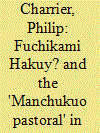|
|
|
Sort Order |
|
|
|
Items / Page
|
|
|
|
|
|
|
| Srl | Item |
| 1 |
ID:
090587


|
|
|
|
|
| Publication |
2009.
|
| Summary/Abstract |
One of the most poetic and mysterious photographic projects of the post-1945 period, Fukase Masahisa's 'Karasu' [Ravens] is here examined in relation to the photographer's entire body of work, his writings, interviews with his family and friends, and consideration of the influence of loss, melancholia, and psychological instability in his art. Although Fukase remains associated with the 'personal photography' movement of the 1960s and 1970s, it is argued that he was, above all, a committed experimenter in photographic narration and self-representation, factors important to the reading and understanding of 'Karasu'. Claims that the ravens in Fukase's images symbolically represent a life now regarded as tragically sorrowful and ill-fated are evaluated and partly challenged.
|
|
|
|
|
|
|
|
|
|
|
|
|
|
|
|
| 2 |
ID:
133471


|
|
|
|
|
| Publication |
2014.
|
| Summary/Abstract |
The art photography of Fuchikami Hakuy? and his circle in Japanese Manchuria is commonly and benignly treated as hybridized modernism, a product of the bending of conventional 1930s Japanese styles (pictorialist, constructivist, realist) through contact with the unfamiliar and the exotic. As such it is deemed reflexive in relation to the stimuli of a new land and peoples, but disconnected from the political, economic, and social processes of imperialism and colonialism in Northeast China. The following article uses both structuralist and post-structuralist theoretical approaches to challenge this interpretation, arguing that through the skilful erasure of colonial violence and disruption, the lyrical images of villages, agriculturalists, and factories produced by Fuchikami and his Mansh? Shashin Sakka Ky?kai (Manchuria Photographic Artists Association) participate directly in processes of state construction in Manchukuo. The development of a quasi-documentary pastoral aesthetic by Fuchikami and the Manchuria photographers is given close attention in the analysis, particularly as it relates to the influence of French Barbizon school painting on late nineteenth- and early twentieth-century Japanese art.
|
|
|
|
|
|
|
|
|
|
|
|
|
|
|
|
|
|
|
|
|